• The Nature of Word Stress.


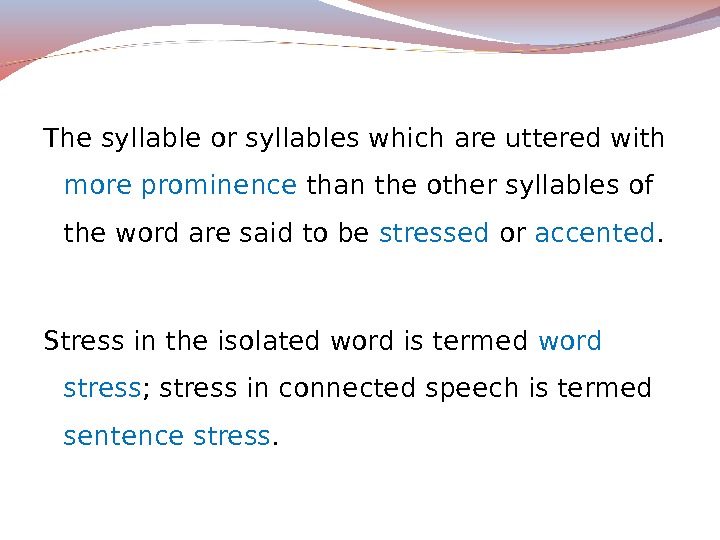

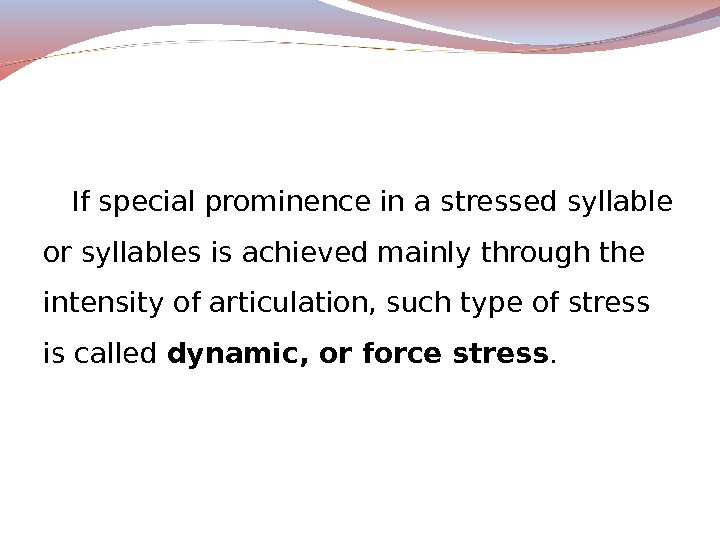
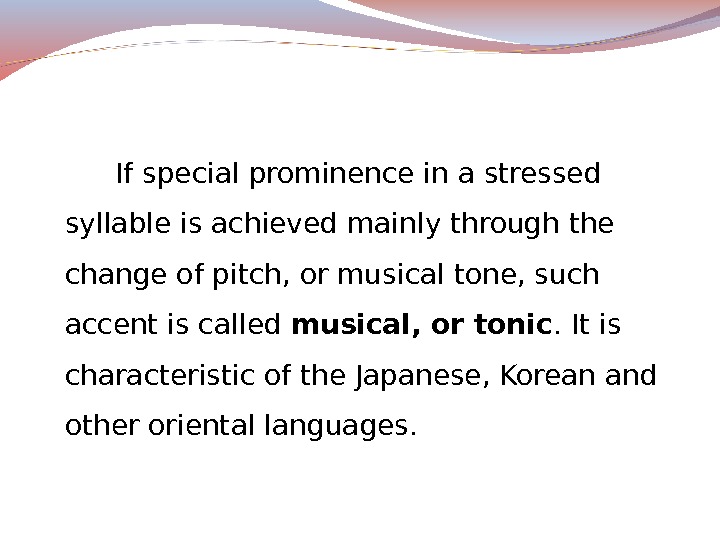


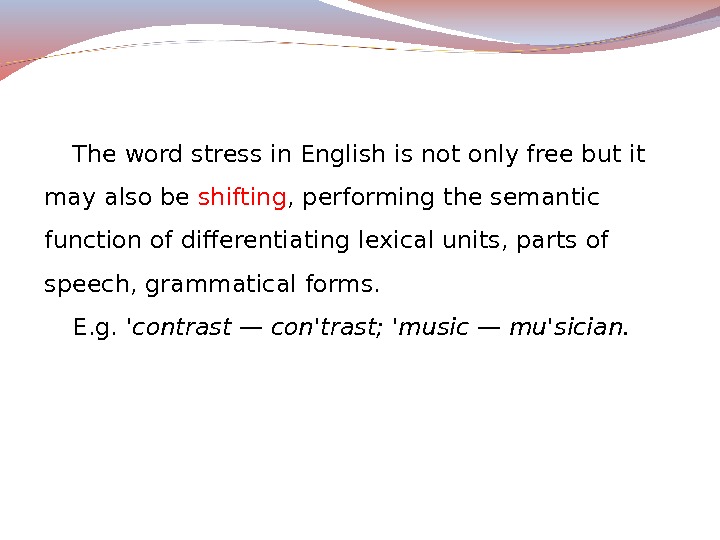
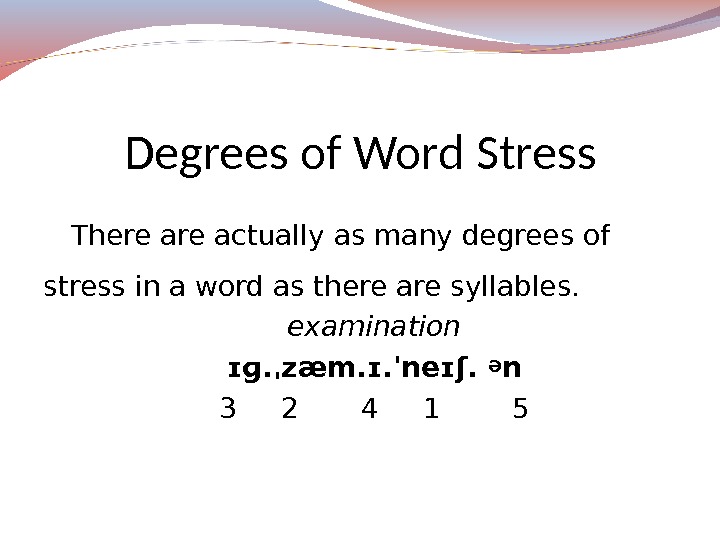
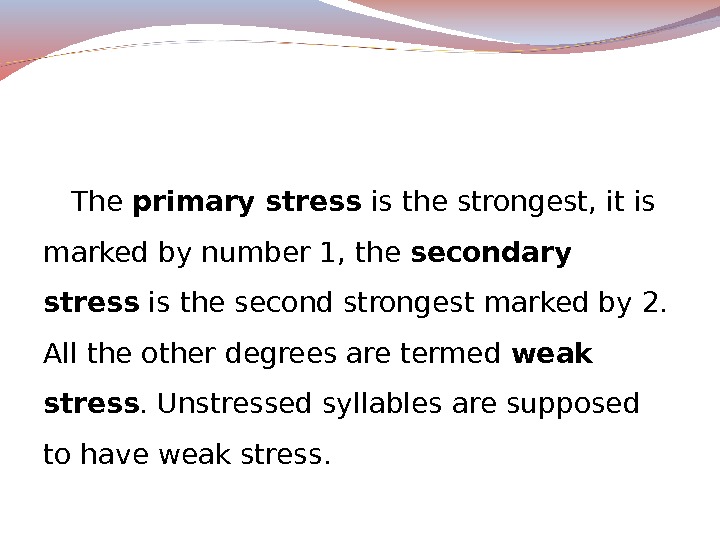

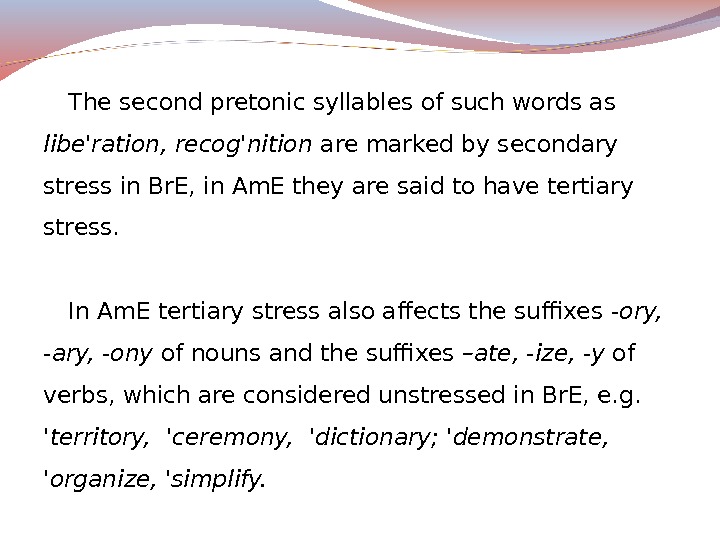
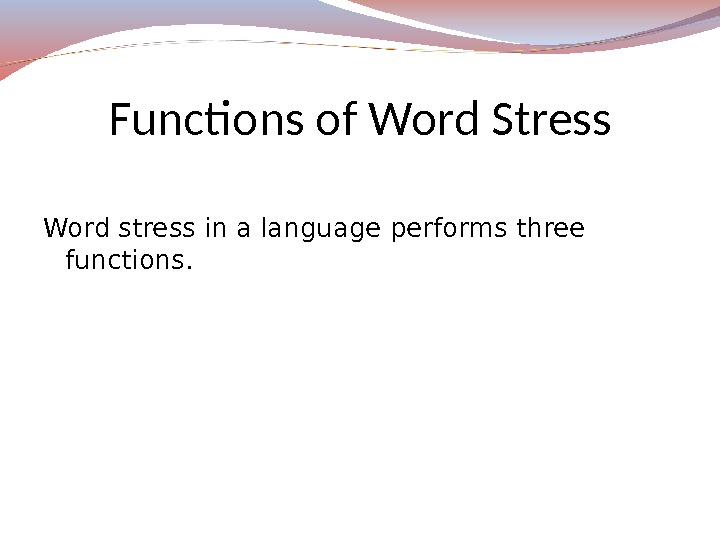


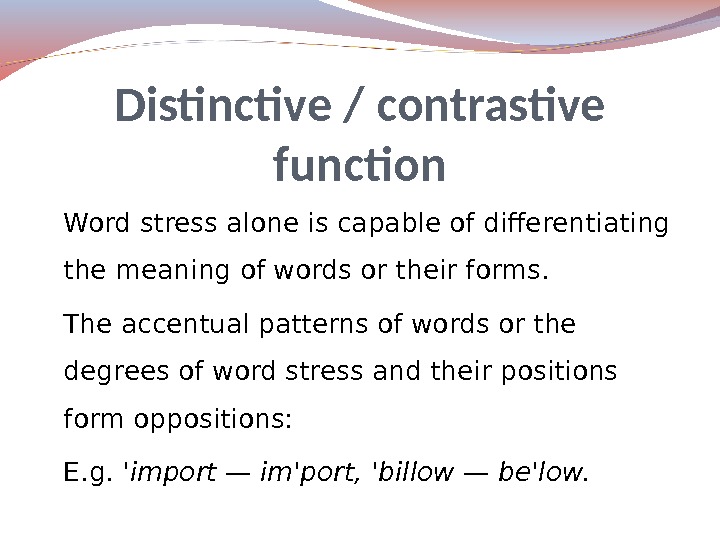
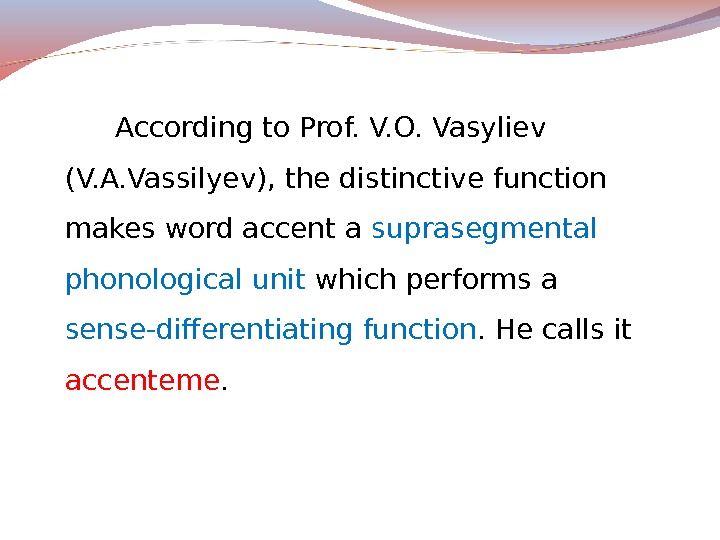
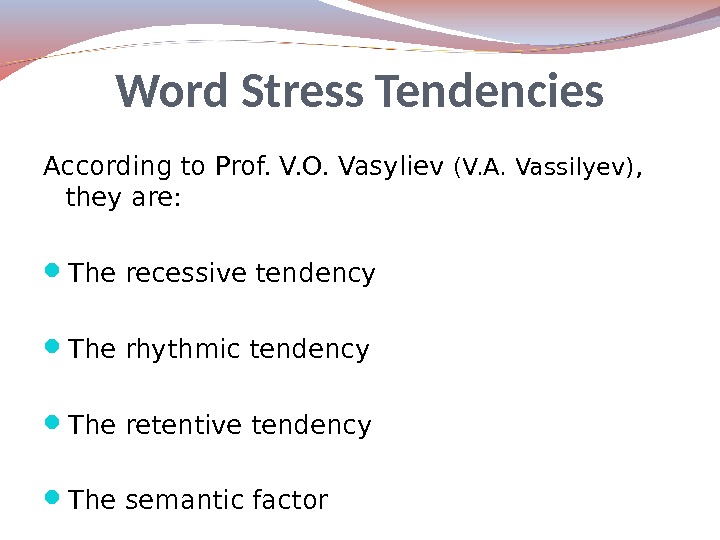


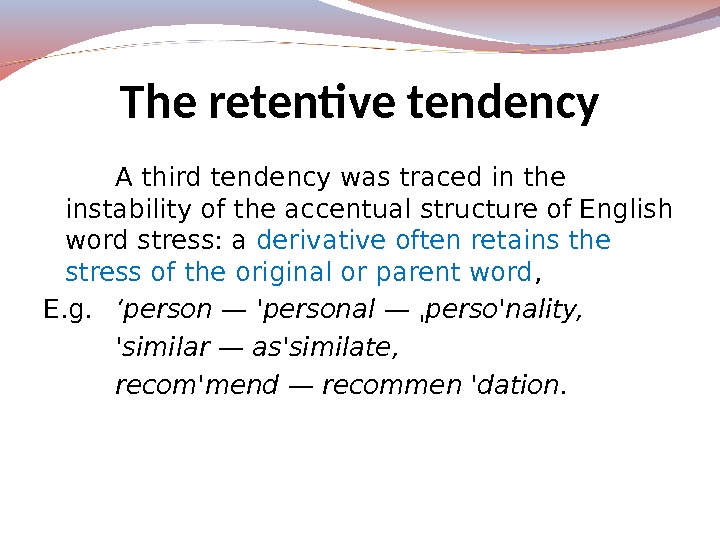
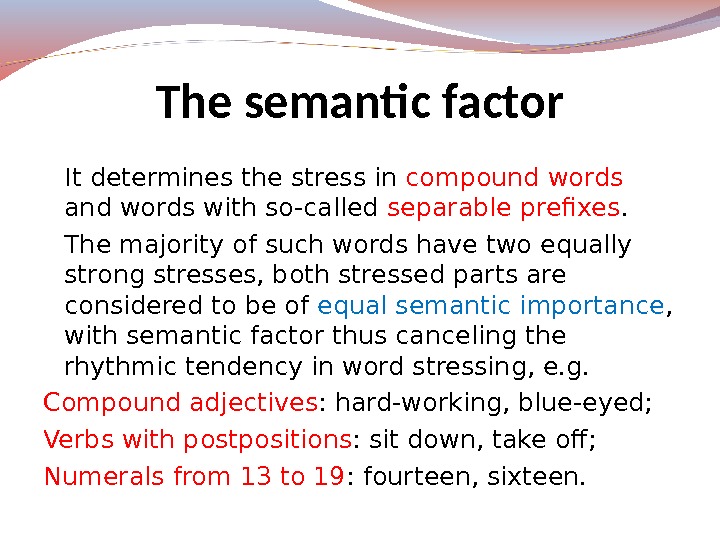

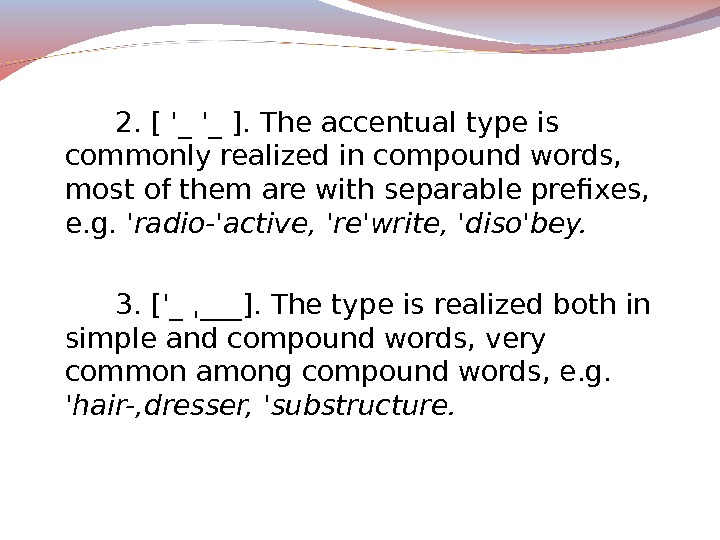
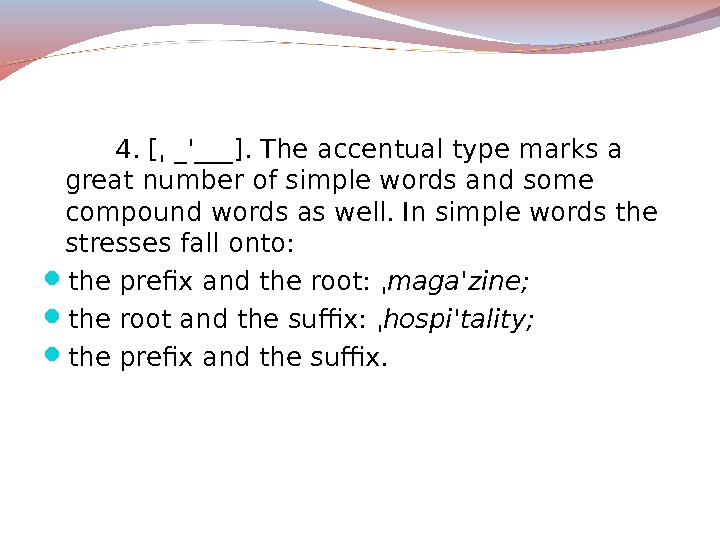

- Размер: 288 Кб
- Количество слайдов: 26
Описание презентации • The Nature of Word Stress. по слайдам
 • The Nature of Word Stress. • The Place of Word Stress in English. The Degrees of Stress. • The Functions and Tendencies of the English Stress. • The Typology of Accentual Structures.
• The Nature of Word Stress. • The Place of Word Stress in English. The Degrees of Stress. • The Functions and Tendencies of the English Stress. • The Typology of Accentual Structures.
 The syllable or syllables which are uttered with more prominence than the other syllables of the word are said to be stressed or accented. Stress in the isolated word is termed word stress ; stress in connected speech is termed sentence stress.
The syllable or syllables which are uttered with more prominence than the other syllables of the word are said to be stressed or accented. Stress in the isolated word is termed word stress ; stress in connected speech is termed sentence stress.
 Word stress can be defined as the singling out of one or more syllables in a word, which is accompanied by the change of the force of utterance, pitch of the voice, qualitative and quantitative characteristics of the sound , which is usually a vowel. In different languages one of the factors constituting word stress is usually more significant than the others.
Word stress can be defined as the singling out of one or more syllables in a word, which is accompanied by the change of the force of utterance, pitch of the voice, qualitative and quantitative characteristics of the sound , which is usually a vowel. In different languages one of the factors constituting word stress is usually more significant than the others.
 If special prominence in a stressed syllable or syllables is achieved mainly through the intensity of articulation, such type of stress is called dynamic, or force stress.
If special prominence in a stressed syllable or syllables is achieved mainly through the intensity of articulation, such type of stress is called dynamic, or force stress.
 If special prominence in a stressed syllable is achieved mainly through the change of pitch, or musical tone, such accent is called musical, or tonic. It is characteristic of the Japanese, Korean and other oriental languages.
If special prominence in a stressed syllable is achieved mainly through the change of pitch, or musical tone, such accent is called musical, or tonic. It is characteristic of the Japanese, Korean and other oriental languages.
 If special prominence in a stressed syllable is achieved through the changes in the quantity of the vowels, which are longer in the stressed syllables than in the unstressed ones, such type of stress is called quantitative. Qualitative type of stress is achieved through the changes in the quality of the vowel under stress.
If special prominence in a stressed syllable is achieved through the changes in the quantity of the vowels, which are longer in the stressed syllables than in the unstressed ones, such type of stress is called quantitative. Qualitative type of stress is achieved through the changes in the quality of the vowel under stress.
 The traditional classification of languages concerning place of stress in a word is into those with a fixed stress and those with a free stress. In languages with a fixed stress the occurrence of the word stress is limited to a particular syllable in a polysyllabic word. In languages with a free stress its place is not confined to a specific position in the word. E. g. ‘appetite — be’ginning — ba’lloon
The traditional classification of languages concerning place of stress in a word is into those with a fixed stress and those with a free stress. In languages with a fixed stress the occurrence of the word stress is limited to a particular syllable in a polysyllabic word. In languages with a free stress its place is not confined to a specific position in the word. E. g. ‘appetite — be’ginning — ba’lloon
 The word stress in English is not only free but it may also be shifting , performing the semantic function of differentiating lexical units, parts of speech, grammatical forms. E. g. ‘contrast — con’trast; ‘music — mu’sician.
The word stress in English is not only free but it may also be shifting , performing the semantic function of differentiating lexical units, parts of speech, grammatical forms. E. g. ‘contrast — con’trast; ‘music — mu’sician.
 There actually as many degrees of stress in a word as there are syllables. examination ɪɡ. ˌzæm. ɪ. ˈneɪʃ. Ə n 3 2 4 1 5 Degrees of Word Stress
There actually as many degrees of stress in a word as there are syllables. examination ɪɡ. ˌzæm. ɪ. ˈneɪʃ. Ə n 3 2 4 1 5 Degrees of Word Stress
 The primary stress is the strongest, it is marked by number 1, the secondary stress is the second strongest marked by 2. All the other degrees are termed weak stress. Unstressed syllables are supposed to have weak stress.
The primary stress is the strongest, it is marked by number 1, the secondary stress is the second strongest marked by 2. All the other degrees are termed weak stress. Unstressed syllables are supposed to have weak stress.
 American linguists distinguish four degrees of word stress and term them: primary stress, secondary stress, tertiary stress and weak stress. The difference between the secondary and tertiary stresses is very subtle and seems subjective.
American linguists distinguish four degrees of word stress and term them: primary stress, secondary stress, tertiary stress and weak stress. The difference between the secondary and tertiary stresses is very subtle and seems subjective.
 The second pretonic syllables of such words as libe’ration, recog’nition are marked by secondary stress in Br. E, in Am. E they are said to have tertiary stress. In Am. E tertiary stress also affects the suffixes -ory, -ary, -ony of nouns and the suffixes –ate, -ize, -y of verbs, which are considered unstressed in Br. E, e. g. ‘territory, ‘ceremony, ‘dictionary; ‘demonstrate, ‘organize, ‘simplify.
The second pretonic syllables of such words as libe’ration, recog’nition are marked by secondary stress in Br. E, in Am. E they are said to have tertiary stress. In Am. E tertiary stress also affects the suffixes -ory, -ary, -ony of nouns and the suffixes –ate, -ize, -y of verbs, which are considered unstressed in Br. E, e. g. ‘territory, ‘ceremony, ‘dictionary; ‘demonstrate, ‘organize, ‘simplify.
 Word stress in a language performs three functions. Functions of Word Stress
Word stress in a language performs three functions. Functions of Word Stress
 Word stress constitutes a word, it organizes the syllables of a word into a language unit having a definite accentual structure, that is a pattern of relationship among the syllables; a word does not exist without the word stress. Constitutive function
Word stress constitutes a word, it organizes the syllables of a word into a language unit having a definite accentual structure, that is a pattern of relationship among the syllables; a word does not exist without the word stress. Constitutive function
 Word stress enables a person to identify a succession of syllables as a definite accentual pattern of a word. Identificatory / recognitive function
Word stress enables a person to identify a succession of syllables as a definite accentual pattern of a word. Identificatory / recognitive function
 Word stress alone is capable of differentiating the meaning of words or their forms. The accentual patterns of words or the degrees of word stress and their positions form oppositions: E. g. ‘import — im’port, ‘billow — be’low. Distinctive / contrastive function
Word stress alone is capable of differentiating the meaning of words or their forms. The accentual patterns of words or the degrees of word stress and their positions form oppositions: E. g. ‘import — im’port, ‘billow — be’low. Distinctive / contrastive function
 According to Prof. V. O. Vasyliev (V. A. Vassilyev), the distinctive function makes word accent a suprasegmental phonological unit which performs a sense-differentiating function. He calls it accenteme.
According to Prof. V. O. Vasyliev (V. A. Vassilyev), the distinctive function makes word accent a suprasegmental phonological unit which performs a sense-differentiating function. He calls it accenteme.
 According to Prof. V. O. Vasyliev (V. A. Vassilyev) , they are: The recessive tendency The rhythmic tendency The retentive tendency The semantic factor Word Stress Tendencies
According to Prof. V. O. Vasyliev (V. A. Vassilyev) , they are: The recessive tendency The rhythmic tendency The retentive tendency The semantic factor Word Stress Tendencies
 In Germanic languages the word stress originally fell on the initial syllable or the second syllable, the root syllable in the English words with prefixes. Unrestricted recessive tendency is observed in the native English words having no prefix, e. g. mother, daughter, brother, swallow, in assimilated French borrowings, e. g. reason, colour, restaurant. Restricted recessive tendency marks English words with prefixes which have no referential meaning now, e. g. foresee, begin, withdraw, apart. The recessive tendency
In Germanic languages the word stress originally fell on the initial syllable or the second syllable, the root syllable in the English words with prefixes. Unrestricted recessive tendency is observed in the native English words having no prefix, e. g. mother, daughter, brother, swallow, in assimilated French borrowings, e. g. reason, colour, restaurant. Restricted recessive tendency marks English words with prefixes which have no referential meaning now, e. g. foresee, begin, withdraw, apart. The recessive tendency
 The rhythm of alternating stressed and unstressed syllables gave birth to this tendency in the present-day English which caused the appearance of the secondary stress in the multisyllabic French borrowings, e. g. ˌrevo’lution, ˌorgani’sation, aˌssimi’lation, etc. It also explains the placement of primary stress on the third syllable from the end in three- and four-syllable words, e. g. ‘cinema, ‘situate, ar’ticulate. The rhythmic tendency
The rhythm of alternating stressed and unstressed syllables gave birth to this tendency in the present-day English which caused the appearance of the secondary stress in the multisyllabic French borrowings, e. g. ˌrevo’lution, ˌorgani’sation, aˌssimi’lation, etc. It also explains the placement of primary stress on the third syllable from the end in three- and four-syllable words, e. g. ‘cinema, ‘situate, ar’ticulate. The rhythmic tendency
 A third tendency was traced in the instability of the accentual structure of English word stress: a derivative often retains the stress of the original or parent word , E. g. ‘person — ‘personal — ˌperso’nality, ‘similar — as’similate, recom’mend — recommen ‘dation. The retentive tendency
A third tendency was traced in the instability of the accentual structure of English word stress: a derivative often retains the stress of the original or parent word , E. g. ‘person — ‘personal — ˌperso’nality, ‘similar — as’similate, recom’mend — recommen ‘dation. The retentive tendency
 It determines the stress in compound words and words with so-called separable prefixes. The majority of such words have two equally strong stresses, both stressed parts are considered to be of equal semantic importance , with semantic factor thus canceling the rhythmic tendency in word stressing, e. g. Compound adjectives : hard-working, blue-eyed; Verbs with postpositions : sit down, take off; Numerals from 13 to 19 : fourteen, sixteen. The semantic factor
It determines the stress in compound words and words with so-called separable prefixes. The majority of such words have two equally strong stresses, both stressed parts are considered to be of equal semantic importance , with semantic factor thus canceling the rhythmic tendency in word stressing, e. g. Compound adjectives : hard-working, blue-eyed; Verbs with postpositions : sit down, take off; Numerals from 13 to 19 : fourteen, sixteen. The semantic factor
 G. P. Torsuyev classifies the accentual types according to the number of stressed syllables, their degree or character (the main and the secondary stress). The most widely spread accentual types are: 1. [‘___]. This accentual type marks both simple and compound words. The accentual structures of this type may include two and more syllables, e. g. ‘father, ‘possibly, ‘mother-in-law, ‘gas-pipe. The Typology of Accentual Structure
G. P. Torsuyev classifies the accentual types according to the number of stressed syllables, their degree or character (the main and the secondary stress). The most widely spread accentual types are: 1. [‘___]. This accentual type marks both simple and compound words. The accentual structures of this type may include two and more syllables, e. g. ‘father, ‘possibly, ‘mother-in-law, ‘gas-pipe. The Typology of Accentual Structure
![2. [ '_ '_ ]. The accentual type is commonly realized in compound words, most 2. [ '_ '_ ]. The accentual type is commonly realized in compound words, most](/docs//english_phonetics_lecture_5_images/english_phonetics_lecture_5_23.jpg) 2. [ ‘_ ‘_ ]. The accentual type is commonly realized in compound words, most of them are with separable prefixes, e. g. ‘radio-‘active, ‘re’write, ‘diso’bey. 3. [‘_ ˌ ___]. The type is realized both in simple and compound words, very common among compound words, e. g. ‘hair-, dresser, ‘substructure.
2. [ ‘_ ‘_ ]. The accentual type is commonly realized in compound words, most of them are with separable prefixes, e. g. ‘radio-‘active, ‘re’write, ‘diso’bey. 3. [‘_ ˌ ___]. The type is realized both in simple and compound words, very common among compound words, e. g. ‘hair-, dresser, ‘substructure.
![4. [ ˌ _'___]. The accentual type marks a great number of simple words and some 4. [ ˌ _'___]. The accentual type marks a great number of simple words and some](/docs//english_phonetics_lecture_5_images/english_phonetics_lecture_5_24.jpg) 4. [ ˌ _’___]. The accentual type marks a great number of simple words and some compound words as well. In simple words the stresses fall onto: the prefix and the root: ˌmaga’zine; the root and the suffix: ˌhospi’tality; the prefix and the suffix.
4. [ ˌ _’___]. The accentual type marks a great number of simple words and some compound words as well. In simple words the stresses fall onto: the prefix and the root: ˌmaga’zine; the root and the suffix: ˌhospi’tality; the prefix and the suffix.
 The variability of the word accentual structure is multiplied in connected speech. The accentual structure of words may be altered under the influence of rhythm , e. g. An ‘unpolished ‘stone but: The ‘stone was un’polished. The tempo of speech may influence the accentual pattern of words. With the quickening of the speed the carefulness of articulation is diminished, the vowels are reduced or elided, the secondary stress may be dropped, e. g. The ‘whole organi’zation of the ‘meeting was ‘faulty.
The variability of the word accentual structure is multiplied in connected speech. The accentual structure of words may be altered under the influence of rhythm , e. g. An ‘unpolished ‘stone but: The ‘stone was un’polished. The tempo of speech may influence the accentual pattern of words. With the quickening of the speed the carefulness of articulation is diminished, the vowels are reduced or elided, the secondary stress may be dropped, e. g. The ‘whole organi’zation of the ‘meeting was ‘faulty.

